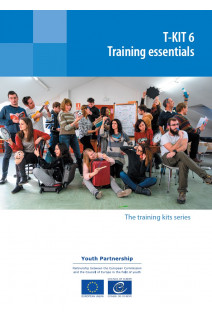The training of youth workers is one of the main priorities of both the European Commission and the Council of Europe, and of their partnership in the field of youth. Youth work is in the spotlight for both institutions and youth workers are essential for the quality of its provision.
This revised T-Kit aims to equip youth workers and youth trainers with the essentials of non-formal education training. It is a practical tool for them to develop training competences and learn more about educational theory, concepts, tools, practices, resources, as well as hands-on tips, as this handbook is written by trainers for trainers and youth workers in the European youth field. Whereas other T-Kits focus on one specific area of youth work training, this one emerges from the broader European youth work context and enables trainers and youth workers to reflect on their daily practice, as this publication follows the logic of an entire training cycle, from beginning to end, of any youth training programme with an international dimension.
The European youth training field has undergone massive changes since this T-Kit was first published in 2002. Especially when it comes to digitalisation, the focus on trainer competences and competence development, training standards and quality criteria for training, recognition of non-formal education, accessibility and diverse ability dimensions. Topics such as access, gender, environment and sustainability, or the focus on learning environments, emotional management and well-being of the trainer have greatly changed non-formal education settings. This T-Kit offers information, links and resources on how to work with young people in non-formal education training settings today and make a difference in their personal lives, as well as their peer groups and communities beyond.
INTRODUCTION CHAPTER 1. TRAINING IN CONTEXT
1.1. Training, training aims and non-formal education
1.2. Training and the trainer
1.3. Intercultural learning and training
CHAPTER 2. TRAINING IN TEAMS
2.1. Multicultural teamwork
2.2. Team building and team life
2.3. From preparation to practice: teamwork during the training course
CHAPTER 3. TRAINING IN MOTION
3.1. Training needs assessment
3.2. Learning, learning outcomes and learning preferences
3.3. Strategies and methodology
3.4. Logistical considerations
3.5. Programme design
3.6. Evaluation
CHAPTER 4. TRAINING IN ACTION
4.1. Group life and the training process
4.2. Dealing with conflicts
4.3. The roles, the group, the team and their responsibilities
4.4. Adapting and running the programme
CHAPTER 5. AFTER TRAINING
5.1. Transfer and multiplying: how to use the training results and how to pass it all on
5.2. Multiplying – What are the possibilities?
5.3. Preparing participants during a training course for transfer and multiplying
CHAPTER 6. CONCLUSIONS – OR, AT THE END IS THE BEGINNING! APPENDIX 1. CO-WORKER PROFILING QUESTIONNAIRE APPENDIX 2. TEAM CO-OPERATION APPENDIX 3. ACCESS NEEDS OF PARTICIPANTS APPENDIX 4. ADD-ON TO BASIC LOGISTICAL CONSIDERATIONS IN CHAPTER 3.4 APPENDIX 5. SESSION OUTLINE APPENDIX 6. SUGGESTED REPORT OUTLINES APPENDIX 7. EVALUATION BIBLIOGRAPHY ABOUT THE AUTHORS AND CONTRIBUTORS







